This article relies largely or entirely on a single source .(September 2018) |
Mark Kerr or Ker (died 1584) was a Scottish churchman who became abbot of Newbattle, and then joined the reformers.
This article relies largely or entirely on a single source .(September 2018) |
Mark Kerr or Ker (died 1584) was a Scottish churchman who became abbot of Newbattle, and then joined the reformers.
Kerr was the second son of Sir Andrew Kerr of Cessford, by Agnes, daughter of Robert Crichton, 2nd Lord Crichton of Sanquhar. In 1546 he was promoted abbot of Newbattle, and on renouncing Catholicism in 1560 continued to hold the benefice in commendam. [1]
Kerr was one of those who, on 26 April 1560, signed at Edinburgh the contract to defend the "evangell of Christ'". [2] Subsequently he was presented to the vicarage of West Linton, Peeblesshire, by the abbot and convent of Kelso, and his presentation was confirmed by the commissioners 4 August 1567, in opposition to one made by the crown. At a parliament held at Edinburgh on 15 December of this year he was appointed one of a commission to inquire into the jurisdiction that should pertain to the kirk. On 20 April 1569 he was nominated an extraordinary lord of session, and he was also chosen a member of the privy council. By one of the articles of the Pacification of Perth in February 1572-3 he was nominated one of the judges for the trial "of all attempts committed against the abstinence be south the water of Tay". [1]
On the fall of Regent Morton in 1578, Kerr was one of the extraordinary council of twelve appointed to carry on the government in the king's name. He was also one of the four delegates deputed on 28 September, after Morton had seized Stirling Castle, to meet Morton's delegates for the purpose of arranging the terms of a reconciliation. Receiving in 1581, after the second fall of Morton, a ratification of the commendatorship of Newbattle, he continued to be a loyal supporter of Esmé Stewart, 1st Duke of Lennox, the favourite of James VI. [1]

On 14 February 1581 Kerr met the English diplomat Thomas Randolph in Edinburgh and asked for a safe-conduct, a travel document, for Lord Seton to go as ambassador to the English court. Randolph refused, as Seton's politics had not previously favoured England, and Kerr took his answer to the king. [3]
Esmé Stewart gave Kerr a "buffet" or cupboard, a key piece of furniture in domestic ritual, for his hall at Prestongrange House and the room was painted for him in 1581 with vivid emblems and comic figures copied from a French illustrated book Richard Breton's Songes drôlatiques de Pantagruel. [4]
On 15 July 1581 Kerr was appointed to hear and report on the case of Sir James Balfour, who was endeavouring to be reinstated in his rights of citizenship. After the raid of Ruthven Kerr was, with Lord Herries, despatched by Lennox with offers of conciliation to the now dominant party. The proposals were rejected. [1]
Kerr died in August 1584. [1]
By his wife, Lady Helen Leslie, a daughter of George Leslie, 4th Earl of Rothes, Kerr had four sons: [1]
and a daughter, Catherine, married to William Maxwell, 5th Lord Herries of Terregles. There were portraits of Kerr and his wife, ascribed to Sir Antonio More, preserved at Newbattle. [1]
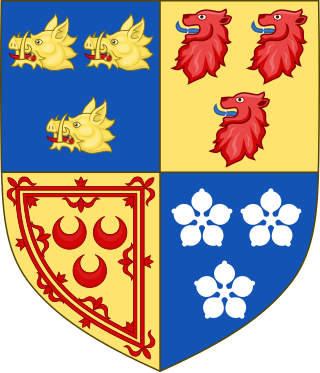
George Gordon, 1st Marquess of Huntly was a Scottish nobleman who took a leading role in the political and military life of Scotland in the late 16th century, and around the time of the Union of the Crowns.
Mark Kerr, 1st Earl of Lothian was a Scottish nobleman and politician. He became the first Earl of Lothian in 1606.
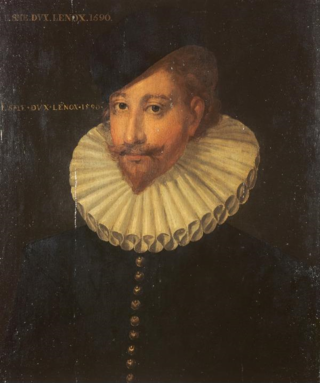
Esmé Stewart, 1st Duke of Lennox, 1st Earl of Lennox, 6th Seigneur d'Aubigny of the Château d'Aubigny at Aubigny-sur-Nère in the ancient province of Berry, France, was a Catholic French nobleman of Scottish ancestry who on his move to Scotland at the age of 37 became a favourite of the 13-year-old King James VI of Scotland. Esmé Stewart was the first cousin of James' father, Henry Stewart, Lord Darnley. Despite his conversion to Calvinism he was never trusted by the Scots and returned to France where he ended his days. Sir James Melville described him as "of nature upright, just and gentle". He was the first to popularise the firstname Esmé in the British Isles.
Holders of the office of Lord Chamberlain of Scotland are known from about 1124. It was ranked by King Malcolm as the third great Officer of State, called Camerarius Domini Regis, and had a salary of £200 per annum allotted to him. He anciently collected the revenues of the Crown, at least before Scotland had a Treasurer, of which office there is no vestige until the restoration of King James I when he disbursed the money necessary for the maintenance of the King's Household.
Alexander Home, 1st Earl of Home and 6th Lord Home, was a Scottish nobleman and Lord Warden-general of all the March. He succeeded as the 6th Lord Home, a Lord of Parliament in the Peerage of Scotland, in 1575, and he was created Earl of Home in the Peerage of Scotland in 1605.
Robert Crichton was a 16th-century Scottish Catholic cleric.

Prestongrange House is a historic house at Prestongrange near Prestonpans, East Lothian, Scotland, UK. It is situated near to two other historic houses, Hamilton House and Northfield House.
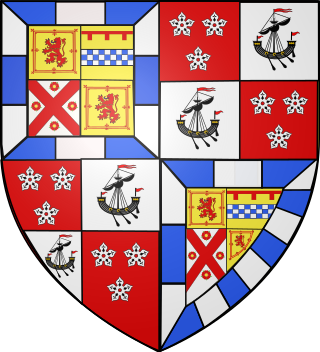
Captain James Stewart, Earl of Arran was created Earl of Arran by the young King James VI, who wrested the title from James Hamilton, 3rd Earl of Arran. He rose to become Lord Chancellor of Scotland and was eventually murdered in 1595.
Margaret Stewart was the younger daughter of James II of Scotland and Mary of Guelders. Once engaged to the Lancastrian Prince of Wales, Margaret instead became the mistress of William Crichton, 3rd Lord Crichton, and the mother of his illegitimate daughter, Margaret Crichton, later Countess of Rothes, and possibly his son, Sir James Crichton, progenitor of the Viscounts of Frendraught. Margaret and Lord Crichton may have been married later, after the death of Crichton's wife.
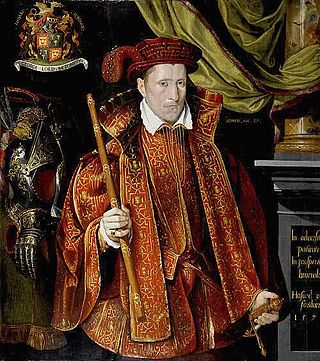
George Seton V, 7th Lord Seton (1531–1586), was a Lord of the Parliament of Scotland, Master of the Household of Mary, Queen of Scots, and Provost of Edinburgh. He was the eldest son of George Seton, 6th Lord Seton, and Elizabeth Hay, a daughter of John Hay, 3rd Lord Hay of Yester. His childhood and schooling were in France.
William Crichton or Creighton was a Scottish Jesuit who became head of the Scots seminary in Flanders.
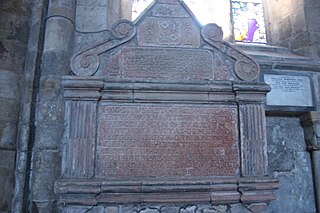
Robert Pitcairn (1520?–1584) was a Scottish administrator, diplomat and judge, secretary of state and commendator of Dunfermline.
John Seton, Lord Barns was a Scottish diplomat, courtier and judge.
Alexander Livingston, 1st Earl of Linlithgow PC was a Scottish nobleman, courtier, and politician. His wife was Helenor Hay, Countess of Linlithgow who was a Royal tutor.
James Stewart, 1st Lord Doune (1529-1590) was a Scottish landowner.
Alexander Abernethy, 6th Lord Saltoun was a Scottish landowner and courtier.
Thomas Kerr of Ferniehirst was a Scottish landowner, Roman Catholic and supporter of Mary, Queen of Scots. He and Jean Scott ended the feud between the Scott family and the Kerrs. Thomas and Jean were both involved with supporting Mary, Queen of Scots.

Helen Leslie, Lady Newbattle (1520-1594) was a Scottish aristocrat and supporter of Mary, Queen of Scots.
William Stewart of Caverston and Traquair, was a Scottish landowner and Captain of Dumbarton Castle.
Sir John Maxwell, 4th Lord Herries of Terregles was a Scottish nobleman and supporter of Mary, Queen of Scots.
![]() This article incorporates text from a publication now in the public domain : Lee, Sidney, ed. (1892). "Kerr, Mark (d.1584)". Dictionary of National Biography . Vol. 31. London: Smith, Elder & Co.
This article incorporates text from a publication now in the public domain : Lee, Sidney, ed. (1892). "Kerr, Mark (d.1584)". Dictionary of National Biography . Vol. 31. London: Smith, Elder & Co.